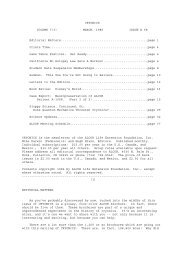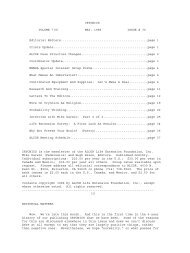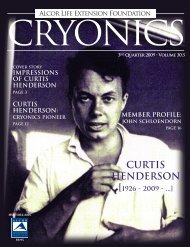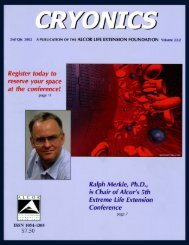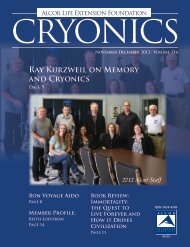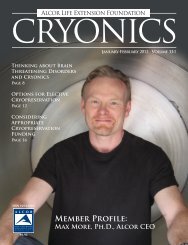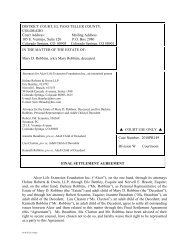Robert Ettinger - Alcor Life Extension Foundation
Robert Ettinger - Alcor Life Extension Foundation
Robert Ettinger - Alcor Life Extension Foundation
You also want an ePaper? Increase the reach of your titles
YUMPU automatically turns print PDFs into web optimized ePapers that Google loves.
peratures of evaporating liquid gases<br />
be used, but the latter are not always<br />
available. Dry ice is in much more<br />
common supply, easier to handle, and<br />
the cost of cooling can be made less<br />
expensive with sufficient insulation.<br />
The temperature of dry ice (-78 C) is<br />
lower than any ordinary deep freeze.<br />
Depending on the insulation and the<br />
number stored, <strong>Ettinger</strong> estimates that<br />
the cost could run from $4 to 10¢ per<br />
frozen person per day. An inexpensive<br />
storage unit could be built with sufficient<br />
room for the person’s body and a<br />
compartment for dry ice immediately<br />
above. The body would be transferred<br />
when a better storage system became<br />
available.<br />
“Response to the book has been<br />
varied—from enthusiasm to irritation<br />
with anything so revolutionary. It has<br />
been reviewed by a number of the major<br />
mass media publications indicating<br />
they are considering the possibility<br />
that <strong>Ettinger</strong>’s is a significant book.<br />
“Jean Rostand wrote a preface stating<br />
that the idea is solid. Gerald Gruman<br />
with his extensive background knowledge<br />
of the history of the concept of<br />
immortality wrote a second preface<br />
noting how great ideas such as this<br />
have often taken considerable time in<br />
taking hold. Penicillin, for example, is<br />
said to have taken 16 years between its<br />
discovery and its use.<br />
“Congratulations are more than in<br />
order. It is a great event toward the defeat<br />
of death.”<br />
Prospect would launch the cryonics<br />
movement, at least in the mind of most<br />
of the public, and <strong>Ettinger</strong> would go on to<br />
a long involvement with it, including such<br />
milestones as publication of other books<br />
and the founding of the Cryonics Institute<br />
in 1976, today one of the two largest cryonics<br />
organizations with over 100 patients.<br />
On the personal level, Bob was a longtime<br />
friend. His kindness and thoughtfulness<br />
were apparent when, for example, he<br />
would go to lengths to photocopy historical<br />
material I was interested in (though he<br />
told me he wasn’t), or the time he wrote a<br />
nice, consoling letter when my mother died<br />
and was buried. He also had an appreciation<br />
of larger issues than merely extending<br />
life, important though it is, as shown when<br />
he became a board member of the Soci-<br />
ety for Venturism, a cryonics-promoting<br />
501(c)(3) organization dedicated, among<br />
other things, to seeing that persons who<br />
are cryopreserved are eventually resuscitated.<br />
(It is a sticking point with some people<br />
that no one will care to resuscitate them,<br />
supposing cryonics would otherwise work.<br />
The Venturists, and some organizations<br />
more recently formed with a similar outlook,<br />
aim to address that possible problem<br />
by offering unconditional support if and<br />
when it should be needed.)<br />
I’ll close this little pastiche with some<br />
words from the man himself, a Cryonet<br />
message in the 1990s that hasn’t lost its relevance<br />
and also recounts some earlier history.<br />
(Again I’ve made minor corrections.<br />
“Mae,” is the former Mae Junod who married<br />
<strong>Ettinger</strong> after his first wife Elaine was<br />
frozen in 1987.)<br />
............................................................................<br />
X-Message-Number: 4414<br />
From: <strong>Ettinger</strong>@aol.com<br />
Date: Thu, 18 May 1995 17:13:15 -0400<br />
Subject: recruitment<br />
Saul Kent says we (cryonicists) are different<br />
in psychology and that we should<br />
try to identify those who are interested but<br />
haven’t done anything about it.<br />
Of course we are different—but not,<br />
as far as I can see, in any visible and useful<br />
way. Who set it in motion originally, or<br />
tried to do so? I wrote a book (after previous<br />
fitful efforts over many years), Evan<br />
Cooper wrote a somewhat similar book,<br />
and Lawrence Jensen, an art professor (yes,<br />
a PAINTER) at Castleton State College<br />
in Vermont, was planning to do so (and<br />
maybe others of whom we haven’t heard).<br />
Those who read my book and instantly responded<br />
included Saul, Curtis Henderson,<br />
Mike Darwin (a child of 12 at the time),<br />
Paul Segall, Harry Waitz, Art Quaife, Greg<br />
Fahy, my brother Alan, my son David (who<br />
explained it on TV at age 15), Jerry Leaf<br />
(I think), Jerry White (I think), and some<br />
others to whom I apologize for omission<br />
of names. But what do they have in common—not<br />
counting my relatives?<br />
The writers or would-be writers of<br />
books—myself, Ev Cooper, and Larry<br />
Jensen—were very different people, with<br />
almost nothing in common, as far as I can<br />
see, or nothing that was not also shared by<br />
enormous numbers of people. The same<br />
goes for the instant responders. The conclusion,<br />
once more, is that the psychologi-<br />
cal and practical pivots are so subtle, or so<br />
dependent on elements of chance, that<br />
identifying them is hopeless.<br />
Eugen Leitl says uploaders should<br />
be prime candidates for cryonics. Again,<br />
while the statistics may show a slight favorable<br />
bias, it isn’t enough to be practically<br />
meaningful. It’s a little bit like saying that<br />
rich people should be prime candidates, because<br />
“logically” they can easily spare the<br />
money, so what’s to lose? But it’s not the<br />
logical that rules—it’s the psychological,<br />
and psychology is not an exact science (or<br />
even a “fuzzy” science).<br />
Locate the interested people? We have<br />
drawers full of names of people who have<br />
sent queries over the years, but on our<br />
sporadic attempts to follow them up we<br />
get mostly no response or notice that they<br />
have moved to an unknown address. (Yes,<br />
we should have been and should be more<br />
systematic about this.)<br />
My general impression, once more,<br />
is that only two things do much good in<br />
cryonics advertising or public relations: (1)<br />
Get as much free publicity as you can, provided<br />
it is dignified, and (2) Use as much<br />
personal contact and influence as practicable.<br />
(The average cost per successful recruitment<br />
is very high, and when you have<br />
someone definitely interested a lot of additional<br />
expense and effort may be justified.)<br />
Finally, as Saul says, support for research<br />
is extremely important both directly,<br />
for improving the patients’ chances, and indirectly<br />
in many ways including its effect on<br />
our credibility. And Saul (with Bill Faloon)<br />
has done much more than most in this area,<br />
as well as having been an important contributor<br />
to the growth of <strong>Alcor</strong>. But again,<br />
this is nothing new.<br />
What is the point of all this rumination?<br />
Perhaps recruitment should focus on<br />
two strategies: (1) Use the shotgun and free<br />
publicity; (2) Keep a hard squeeze on those<br />
already in the vise. Mae occasionally gives<br />
money to the Republicans, and every donation<br />
is instantly followed by a flood of<br />
requests for more and larger donations. Of<br />
course, that doesn’t work with her; the cost<br />
of the request mailings probably exceeds<br />
her total donations. But one supposes their<br />
technique must work, on average, since<br />
they keep doing it.<br />
<strong>Robert</strong> <strong>Ettinger</strong><br />
Cryonics Institute<br />
Immortalist Society<br />
www.alcor.org Cryonics/Fourth Quarter 2011 17



